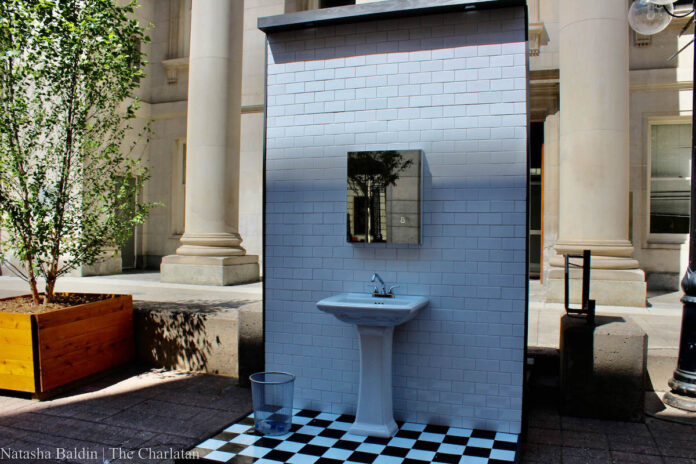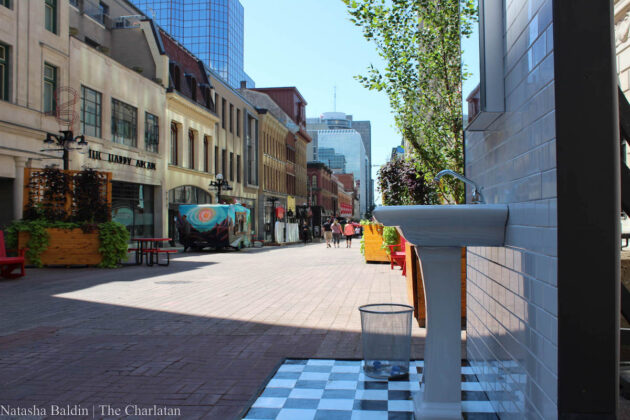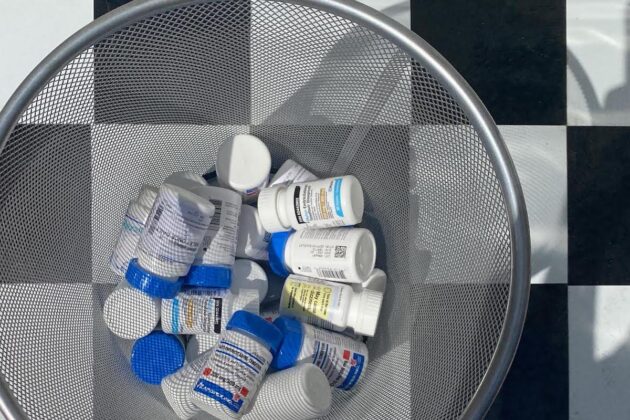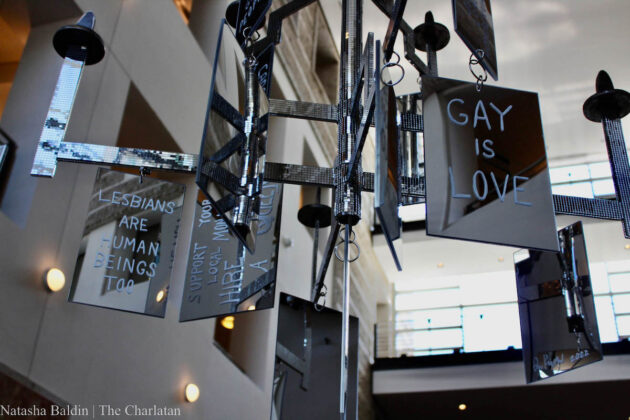
This year, Capital Pride organized a public art project to celebrate and educate people on LGBTQ+ culture and history.
The initiative featured six art installations located across downtown Ottawa, which were on display from Aug. 20 to 28. Among selected artists were Carleton University alumnus Mike Steinhauer and local artist Don Kwan.
Steinhauer’s piece boldly stood in the middle of Sparks Street. Titled Medicine Cabinet, the three-metre-tall installation replicates a New York City bathroom in the 1980s—a time when the city was the epicentre of the AIDS epidemic.
Attached to the subway-tiled wall is a medicine cabinet, which viewers can open and close. Inside the cabinet and in the wastebasket on the installation’s checkered floor are empty pill bottles, representing retroviral medication given to HIV-positive individuals.
Steinhauer said he wants to highlight the struggle HIV-positive individuals faced during the 1980s, as many early AIDS medications used to delay its onset had negative side effects.
“The initial drug that was approved [to treat AIDS] was AZT, which was incredibly potent,” he said. “It’s remembering what these individuals went through. While it saved lives, [AZT] was really toxic and had side effects.”
After graduating from Carleton in 2016 with a master’s in art history, Steinhauer now works as a program and policy manager for Heritage Canada. He said his passion for history inspired him to create this piece.
“It’s the historian and archivist in me that always wants to look back for a moment,” he said. “We all know that today, the Pride festival all over the world is very much about celebrating who we are, but for me it is very important to remember … our history.”
Kwan took a similar approach to his public art installation, drawing inspiration from LGBTQ+ history. He looked to the We Demand Rally, the first large-scale gay rights demonstration in Canada, which took place in Ottawa on Aug. 28, 1971.
Kwan said the piece combines the historic rally with two “queer hallmarks”: the chandelier and the disco ball.
Displayed in the foyer of Ottawa City Hall, We Demand, Disco Chandelier features a chandelier base covered in disco ball tiles. Rectangular mirrored panels hang from the chandelier, each containing a message inspired by the We Demand Rally picket signs.
“I’ve always loved the messages that are put on picket signs. It’s so direct and concise,” Kwan said. “Regular people putting the most important message on a very small piece of cardboard—I love that because it’s so powerful.”
The geometric elements of the chandelier also represent Kwan’s identity as a third-generation Chinese-Canadian, he said.
“I wanted to create that geometric oriental hint,” he said. “In Asian culture, there is no language for queerness, so that really interests me as well, because it’s new territory.”
Kwan said the mirrors and reflective surfaces featured in the installation give viewers the opportunity to see themselves within the artwork.
“The glass reflects our image,” he said. “I think it’s very important for me as a queer Asian artist—and for everyone else—to see ourselves reflected in museums and institutions and gallery spaces and, in this case, public art.”
For Steinhauer and Kwan, the public art project is about starting conversations by using LGBTQ+ history as a lens for viewing the inequities the community still faces today.
“The AIDS crisis is not over yet, and it could be done within a decade or so,” Steinhauer said. “I hope to see conversation about [AIDS] prevention … about the inequities that still exist today, and what each one of us can do to make sure we can deconstruct some of those roadblocks.”
Kwan echoed this sentiment and said he hopes people can connect to the past and present challenges highlighted within his artwork.
“I hope people bring it back to their dining room table … to their circle of friends and families and really reflect on the meaning behind the work, the meaning behind the history and the struggle that we all share,” Kwan said.
The Government of Canada recently announced a $150,000 investment in Capital Pride, which allocated funds to support the six artists selected to participate in the public art project.
“This investment will showcase 2SLGBTQ+ artists and highlight Ottawa as a 2SLGBTQ+-friendly tourism destination,” the announcement said.
Kwan said he is thankful for the support in turning his vision into a reality.
“I never saw myself reflected in institutions. For Capital Pride to invite [and] compensate me, it really makes me feel embraced, it makes me feel heard [and] it makes me feel seen,” he said. “I’m hoping [the piece] will resonate with others that feel the same.”
Featured image by Natasha Baldin.












